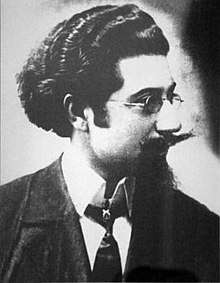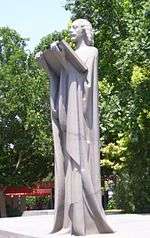Armen Tigranian
Armen Tigrani Tigranian or Tigranyan or Dikranian (Armenian: Արմեն Տիգրանյան; 26 December 1879, Alexandropol – 10 February 1950, Tbilisi)[1] was an Armenian music composer and conductor. His best-known works were two national operas, Anoush (premiere: Alexandropol, 4 (17) August 1912, the first opera performance in Armenia) and Davit Bek (1950); the latter of which premiered only months before his death and was his final composition.[2]
Armen Tigranian | |
|---|---|
 Armen Tigranian | |
| Born | December 26, 1879 |
| Died | February 10, 1950 (aged 70) |
| Years active | 1890s–1950 |
Biography
Tigranian was born in Alexandropol in the Russian Empire (present-day Gyumri, Armenia).[3] He started becoming interested in music at a very early age. Tigranian received his musical training in Tbilisi,[4] and in 1902, he finished his education at the Tbilisi Music College, studying composition with Makar Ekmalyan. He devoted himself to teaching and continued composing music, mainly songs and romances in Armenian folk traditions.

Tigranian's opera Anoush, written in 1908 and remodelled in 1932, is called the "national opera of the Armenian people".[5] Anoush, based on Hovhannes Tumanian's story of country romance and tragedy captured the attention of audiences and became a perennial of the concert repertoire.[6] The American premiere of "Anoush" took place on May 27, 1923 at the Lexington Opera House in New York, in a presentation marketed toward the Armenian immigrant audience. What was billed as the "professional American premiere" of Anoush took place in 1981 at Michigan Opera Theatre.
The history of Karabakh Melikdoms inspired the opera David Bek (1950).[7]
Among the other works by Tigranian are the drama Leily and Mejnun, Eastern Dance for symphonic orchestra and New Spring chorus for 4 voices.
Awards
- Honoured Art Worker of Armenian SSR, 1935
- Honoured Art Worker of Georgian SSR, 1936
- Lenin order[9]
Bibliography
- Атаян Р., Мурадян М., Армен Тигранян, М., 1966. (in Russian)
References
- Hovhanness I. Pilikian: Armenian Cinema: A Source Book, p. 51
- Opera Glass
- DeVoto, Bernard Augustine (1958). "Saturday Review". 41. Saturday Review Associates: 57. Retrieved 15 January 2016.
Armen Tigranian was born in 1879 in Alexandropol (...)
Cite journal requires|journal=(help) - DeVoto, Bernard Augustine (1958). "Saturday Review". 41. Saturday Review Associates: 57. Retrieved 15 January 2016. Cite journal requires
|journal=(help) - Ovation: Volume 2, 1981
- Historical Dictionary of Armenia, by Rouben Paul Adalian, p. 454
- The Heritage of Armenian Literature: From the Sixth to the Eighteenth Century. Jack Hacikyan, Detroit: Wayne State University Press, 5–6.
- Tigranyan's Tombstone at Tokhmakh cemetery
- Biography (in Russian)